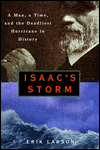Isaac's Storm and predicting the Big Uneasy

It's "the story of what can happen when human arrogance meets the uncontrollable force of nature."
It sounds like another story about the disaster that has befallen New Orleans. But, it is a publisher's description of a 1999 best seller that chronicles a monster hurricane that wiped out Galveston, Texas in 1900. The storm precipitated what was -- until last week -- the greatest natural disaster in U.S. history.
Isaac's Storm is told through the eyes of Isaac Cline, resident meteorologist for the U.S. Weather Bureau, who, according to the book's cover, "failed to grasp the true meaning of the strange deep-sea swells and peculiar winds" that preceeded the hurricane.
Adding to the chorus of unheeded warnings is an October 2004 story in National Geographic, brought to our attention by Al Tompkins of the Poynter Institute. The detail of this article's predicition is absolutely eerie:
It was a broiling August afternoon in New Orleans, Louisiana, the Big Easy, the City That Care Forgot. Those who ventured outside moved as if they were swimming in tupelo honey. Those inside paid silent homage to the man who invented air-conditioning as they watched TV "storm teams" warn of a hurricane in the Gulf of Mexico. Nothing surprising there: Hurricanes in August are as much a part of life in this town as hangovers on Ash Wednesday.
But the next day the storm gathered steam and drew a bead on the city. As the whirling maelstrom approached the coast, more than a million people evacuated to higher ground. Some 200,000 remained, however—the car-less, the homeless, the aged and infirm, and those die-hard New Orleanians who look for any excuse to throw a party.
The storm hit Breton Sound with the fury of a nuclear warhead, pushing a deadly storm surge into Lake Pontchartrain. The water crept to the top of the massive berm that holds back the lake and then spilled over. Nearly 80 percent of New Orleans lies below sea level—more than eight feet below in places—so the water poured in. A liquid brown wall washed over the brick ranch homes of Gentilly, over the clapboard houses of the Ninth Ward, over the white-columned porches of the Garden District, until it raced through the bars and strip joints on Bourbon Street like the pale rider of the Apocalypse. As it reached 25 feet (eight meters) over parts of the city, people climbed onto roofs to escape it.
Thousands drowned in the murky brew that was soon contaminated by sewage and industrial waste. Thousands more who survived the flood later perished from dehydration and disease as they waited to be rescued. It took two months to pump the city dry, and by then the Big Easy was buried under a blanket of putrid sediment, a million people were homeless, and 50,000 were dead. It was the worst natural disaster in the history of the United States.
When did this calamity happen? It hasn't—yet. But the doomsday scenario is not far-fetched. The Federal Emergency Management Agency lists a hurricane strike on New Orleans as one of the most dire threats to the nation, up there with a large earthquake in California or a terrorist attack on New York City. Even the Red Cross no longer opens hurricane shelters in the city, claiming the risk to its workers is too great.
"The killer for Louisiana is a Category Three storm at 72 hours before landfall that becomes a Category Four at 48 hours and a Category Five at 24 hours—coming from the worst direction," says Joe Suhayda, a retired coastal engineer at Louisiana State University who has spent 30 years studying the coast. Suhayda is sitting in a lakefront restaurant on an actual August afternoon sipping lemonade and talking about the chinks in the city's hurricane armor. "I don't think people realize how precarious we are,"
Suhayda says, watching sailboats glide by. "Our technology is great when it works. But when it fails, it's going to make things much worse."
The chances of such a storm hitting New Orleans in any given year are slight, but the danger is growing. Climatologists predict that powerful storms may occur more frequently this century, while rising sea level from global warming is putting low-lying coasts at greater risk. "It's not if it will happen," says University of New Orleans geologist Shea Penland. "It's when."
Earlier: Did it have to happen?

0 Comments:
Post a Comment
<< Home